According to eMarketer, retail media will be bigger than connected TV, digital audio, and traditional television advertising combined in 2027 and second only to paid search in total ad spend.
As the end of third-party cookies approaches and brands search for innovative ways to reach customers, retail media offers a promising option for reaching high-intent customers.
Media publishers must understand the intricacies of this burgeoning trend so they can better position themselves to take advantage of its opportunities, drive more brand conversions, and remain competitive.
Table of contents:
- What retail media is
- How retail media networks fuel brand growth
- 3 lessons publishers can learn from retail media
Retail media offers a new way to steer consumer decisions
Retail media enables brands to place ads directly on retailer websites, apps, and beyond.
Retail media networks such as Walmart, Target, Home Depot, Amazon, and Best Buy are leading this movement. These companies offer bespoke retail media services on their websites and in their physical stores, essentially becoming media publishers themselves.
This approach brings a brand’s marketing messages closer to the point of sale, enhancing the likelihood of conversion by reaching consumers at a crucial decision-making moment.
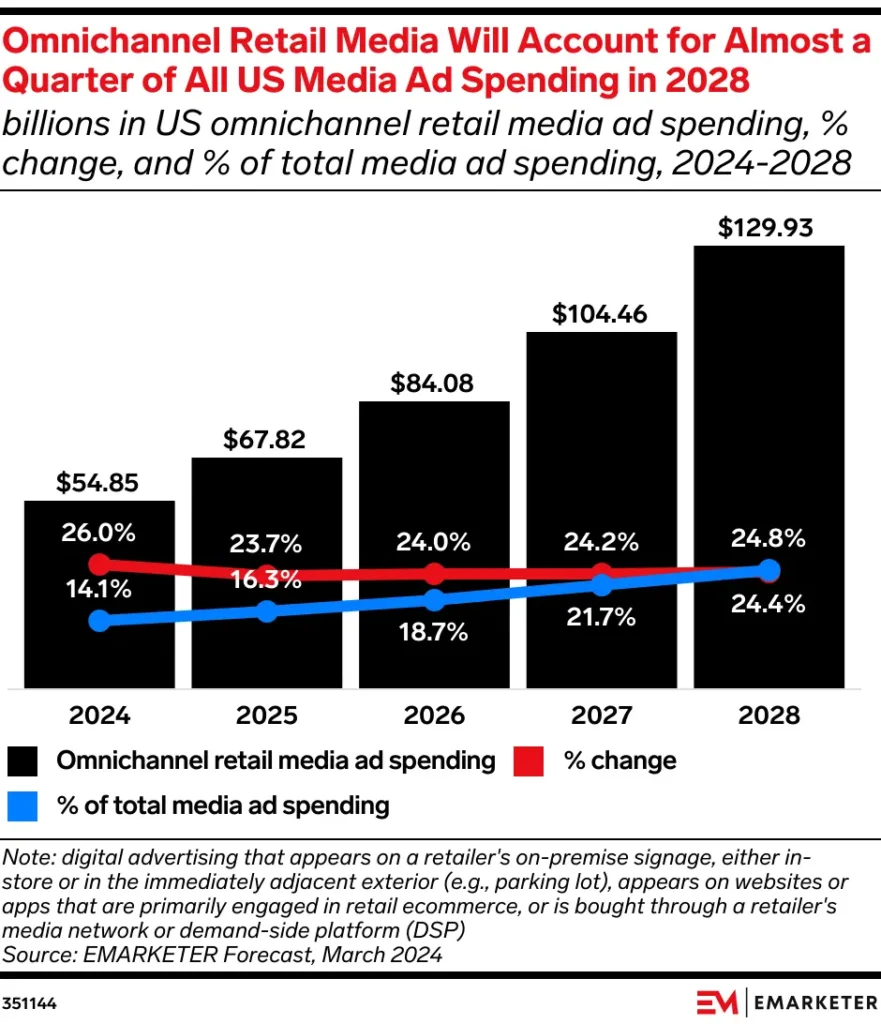
High-conversion tactics have fueled significant retail media ad spending growth with a promising future projected by eMarketer.
Retail media networks use their audience data, size, and industry authority to boost brands in various ways. Here are some common channels used to promote brands:
- Retailer’s website homepage
- Category pages
- Product detail pages
- Search pages
- Social media posts
These networks may use in-store ads within the retailer’s physical environment, but they primarily focus on digital promotion methods.
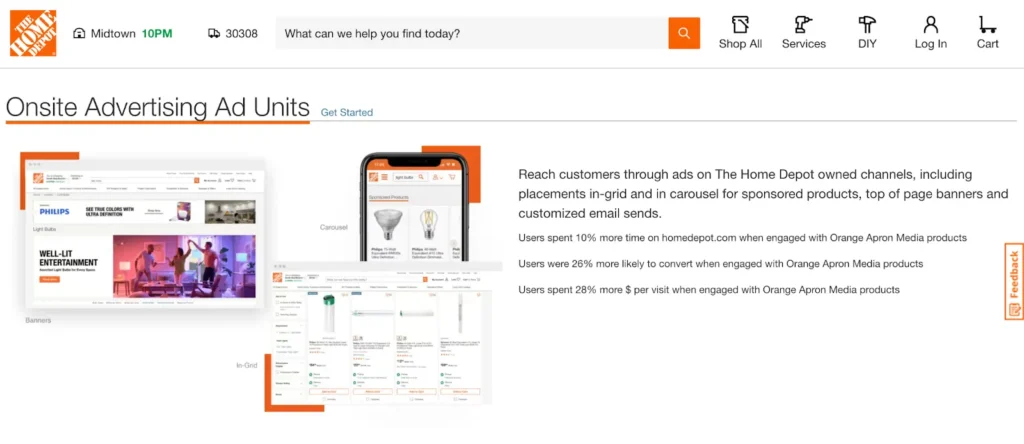
The Home Depot’s Orange Apron Media provides opportunities to reach consumers with ads embedded in various locations on their website, among other advertising services.
Differentiating between retail and commerce media
Retail media and commerce media are often bundled together, yet it’s important to understand their unique qualities.
- Retail media focuses on advertising within a retailer’s platforms, usually in what’s known as “the last mile,” just prior to purchase.
- Commerce media reaches consumers earlier in their journey, engaging them throughout the shopping experience–-even beyond retailer-specific sites.
Commerce media encompasses commerce content, a key element of partnerships that melds content creation with e-commerce.
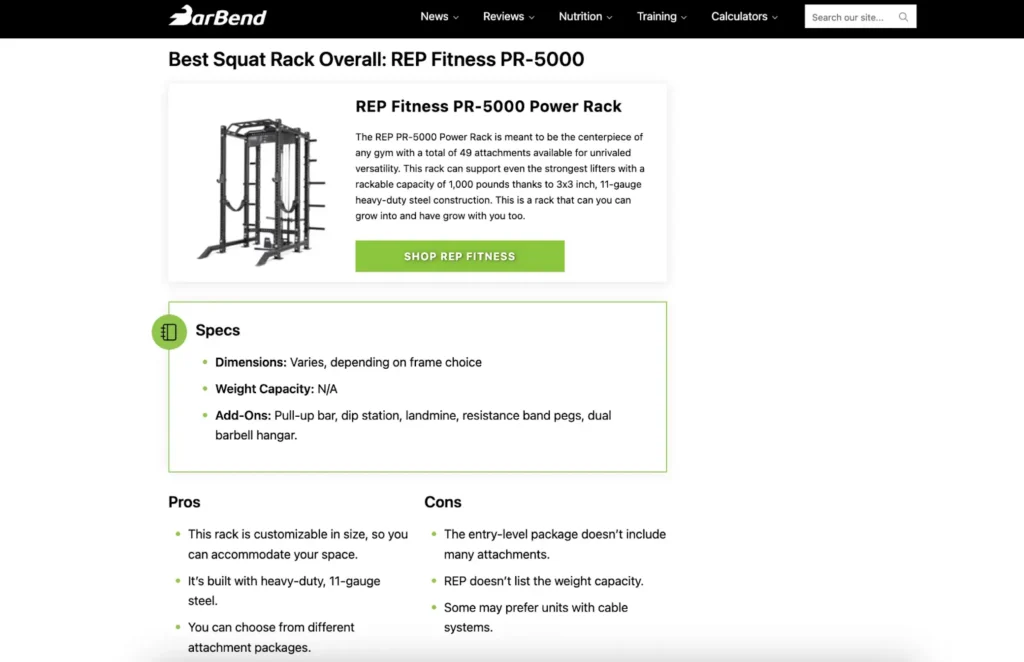
Strength training publication BarBend uses commerce content to compile helpful exercise equipment lists that include affiliate links, providing value to readers while cultivating an income stream.
Commerce content primes consumers before they arrive at the retailer’s online or physical store by providing informative content that aids purchase decisions, such as buyer’s guides or product reviews. It provides value through education and seamlessly weaves product mentions into engaging user experiences, fostering trust and loyalty by prioritizing helpfulness over overt promotion.
Retail media captures consumer attention at the point of sale, while commerce media guides shoppers through multiple journey stages. Embracing these media channels ensures that brands remain competitive and position themselves for sustained success.
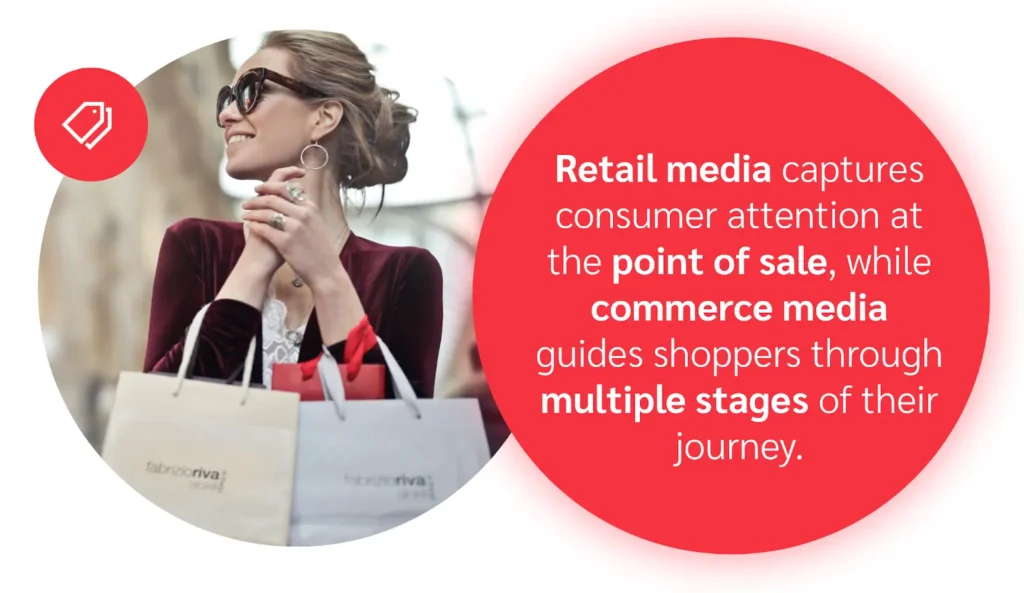
How retail media networks chart the course for brand growth
As retail media surges in popularity, brands are seeing its clear benefits. This new frontier in advertising offers great opportunities for growth and measurement—all while meeting consumers’ high expectations for personalization.
Creating a timely, relevant consumer experience
Retail media provides the personalized shopping experience consumers love, leading to better ROI for brands. Statista reports that over 80 percent of brands have seen increased consumer spending thanks to personalized experiences.
These networks can use first-party data to deliver customers personalized product recommendations and promotions. Tailoring the shopping experience to individual preferences enhances engagement and satisfaction.

Source: Statista
Tailored ads create a smoother and more engaging experience for consumers because they integrate into the shopping experience.
Personalized experiences are crucial for maintaining ad effectiveness and capturing attention. Nearly 90 percent of consumers prefer personalized ads, and 87 percent say they’re more likely to engage with ads for products they’re interested in or shopping for.
Contrary to popular belief, consumers don’t dislike ads. They want ads to enhance their online experiences, and retail media offers a unique way to achieve this.

Source: IAB
Driving measurable sales growth
Retail media precisely targets brand messages to audiences actively shopping on e-commerce platforms, boosting the chances of conversions and directly impacting sales.
Brands can easily track campaigns to see how their marketing efforts affect sales. Additionally, retail media networks offer extensive access to first-party data, allowing brands to adjust strategies and optimize performance quickly. Understanding consumer preferences and behaviors helps brands tailor their approach for the best return on investment.
A power tool manufacturer can leverage Home Depot’s knowledge of its customers’ buying habits and browsing behavior on homedepot.com to promote a new table saw to them more effectively
As consumers save more and spend less on non-essentials, brands seek performance-based advertising that converts—and retail media fits the bill.

Source: Deloitte
3 critical lessons publishers can learn from retail media
Retail media’s meteoric rise can be attributed to several factors:
- The decline of third-party cookies. Brands are moving towards first-party data solutions provided by retail media networks offering abundant consumer insights.
- Shift to online shopping. More consumers are on e-commerce platforms where retail media ads have higher visibility and engagement.
- Measurable ROI. Retail media allows brands to track consumer interactions from ad clicks to purchases, enabling real-time optimization and precise performance tracking.
The success of retail media presents publishers with a valuable opportunity to adapt to brands’ evolving needs. Here are the key lessons publishers can learn from this growing trend.
1. Invest in personalizing the reader experience
Fostering a personalized reader experience is paramount for publishers seeking to emulate the success of retail media strategies. To achieve this, publishers should invest in shoring up their first-party data strategies.
Use data analytics and AI technologies to better understand reader preferences, behaviors, and engagement patterns. Some potential user data points include reading habits, content interactions, and demographic information.
Creating a tailored, highly curated reading experience sets premium publishers apart. You can offer accurate and deep insights, providing brands with a comprehensive understanding of their audience demographics, behaviors, and engagement patterns. This rich data enables brands to precisely target their marketing campaigns precisely tailor messaging to specific audience segments, and optimize ad placements.
It also presents publishers with other benefits, such as:
- Encouraging brand loyalty
- Boosting subscriptions
- Raising subscriber retention
- Increasing time-on-page and engagement
- Lowering reader acquisition costs

2. Seamlessly integrate your advertising into the shopper’s journey
According to Deloitte, consumers favor less disruptive ad experiences, and ads that are embedded into their content experience. To capitalize on this growing trend, publishers can develop more integrated advertising experiences—similar to those in retail media. They have various alternative advertising mediums that can achieve this.
Native advertising seamlessly blends traditional display advertising with editorial material, providing a non-disruptive and engaging format that resonates. This approach elevates the user experience and allows brands to authentically connect with consumers in context.
In addition to traditional display, commerce media enables publishers to capitalize on the trend of shoppable content. By integrating commerce elements within their content, publishers can bridge the gap between content discovery and purchase intent. This approach offers a streamlined, frictionless experience tailored to the buyer’s journey.
Publishers can also produce high-quality branded content that aligns with the publication’s voice and the brand’s messaging, creating impactful storytelling opportunities that drive brand affinity and consumer loyalty.
This holistic approach to integrated advertising drives revenue diversification while cultivating deeper audience engagement and brand partnerships.
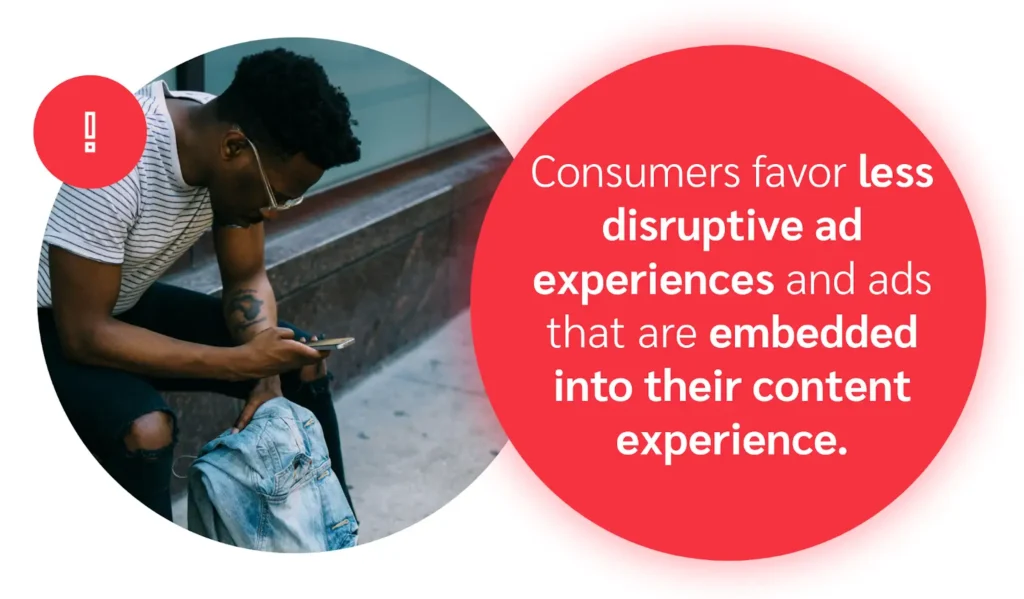
Source: Deloitte
3. Focus on performance-based offerings for brands
Brands increasingly seek a verifiable return on ad spend (ROAS). Investing in measurable, performance-based advertising options like commerce content, enables publishers to compete with conversion-focused retail media offerings.
One of the main advantages of commerce content is that it clearly shows how it impacts conversion metrics. Though these placements are traditionally unpaid, it allows brands to see transparent performance data and a clear ROI—empowering publishers to negotiate commission rates or seed deeper partnership conversations.
Publishers can invest in robust tracking, measurement, and reporting tools for upper-funnel brand offerings like branded content. By emphasizing outcomes, publishers can emulate the success seen in retail media and forge stronger, results-oriented partnerships with brands.
Focusing on measurability helps publishers optimize future content and reassures brands that their marketing budget is well-spent.
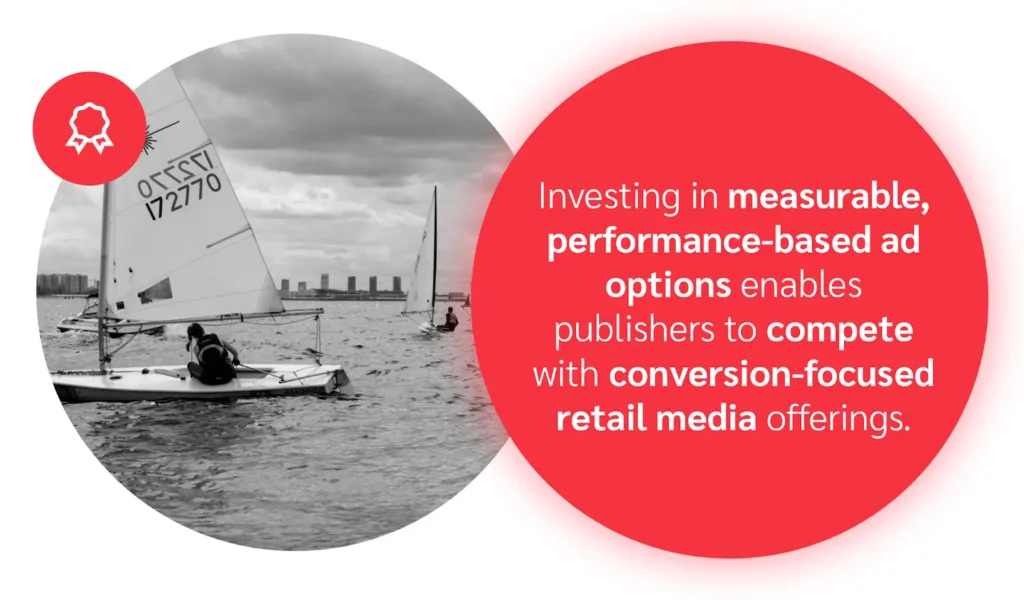
Riding marketing trend waves can create long-lasting partnerships
As retail and commerce media evolve, staying abreast of technological advancements and shifting consumer preferences allows publishers to meet ever-increasing brand expectations.
By using data-driven insights and embracing innovative ad technologies, publishers can craft personalized, engaging experiences that resonate with target audiences and deliver superior value to brands.
To explore how retail and commerce media can revolutionize your marketing strategy, contact your impact.com representative or join the impact.com Marketplace today.
Read more about how publishers can monetize their content:
- What major media publishers can learn from influencers during times of change [blog]
- Beyond banner ads: How branded content is redefining advertising for publishers [blog]
- The publishers’ guide to commerce content [blog]
FAQs
The primary objective of retail media is to enhance brand visibility and engagement within the digital landscape, precisely targeting consumers during key touchpoints in their purchasing journey.
Using retail media platforms, brands showcase their products or services to a receptive audience, driving conversion and fostering brand loyalty through tailored ad placements.
Another key goal of retail media is to optimize advertising spend by providing measurable and data-driven results to advertisers. This approach allows businesses to refine their marketing strategies based on real-time performance metrics, ensuring that each advertising dollar invested yields maximum returns.
Through the strategic placement of ads on retail media platforms, businesses can:
- Increase sales
- Gain valuable insights into consumer behavior
Let’s say a skincare brand collaborates with a popular online beauty retailer to showcase its latest range of anti-aging products.
Through this partnership, the skincare brand strategically places sponsored product listings within the retailer’s website, specifically targeting users browsing skincare categories or seeking anti-aging solutions.
By using the retailer’s vast customer base and refining placements based on the company’s first-party data, the skincare brand effectively boosts awareness, drives traffic to its product pages, and ultimately converts interested shoppers into customers.
Let’s say a supplement brand offers an affiliate program to help spread awareness about their products. A wellness publication that’s enrolled in their program then creates an in-depth article on the benefits of specific vitamins and how they promote well-being.
The publication strategically places affiliate links to the brand’s supplement products within the article. Each link leads readers to dedicated product pages where the reader can make a purchase. The publication will receive a commission for each purchase their audience makes with the affiliate link.
The wellness publication tracks affiliate link data and measures the campaign’s success through key performance indicators like click-through rates, add-to-cart metrics, and eventual purchases.
This immersive commerce content experience educates readers on the value of supplements while driving direct sales for the brand.
Though retail media offers brands many advantages, there are some hurdles they may encounter:
- Negotiating costs and placements with retailers as the competition for ad inventory increases
- Tailoring marketing strategies and content for each individual retail media network
- Ensuring consistent brand voice across various retail media channels
- Accessing valuable customer insights held by retailers
- Measuring a complex consumer journey with multiple touchpoints




